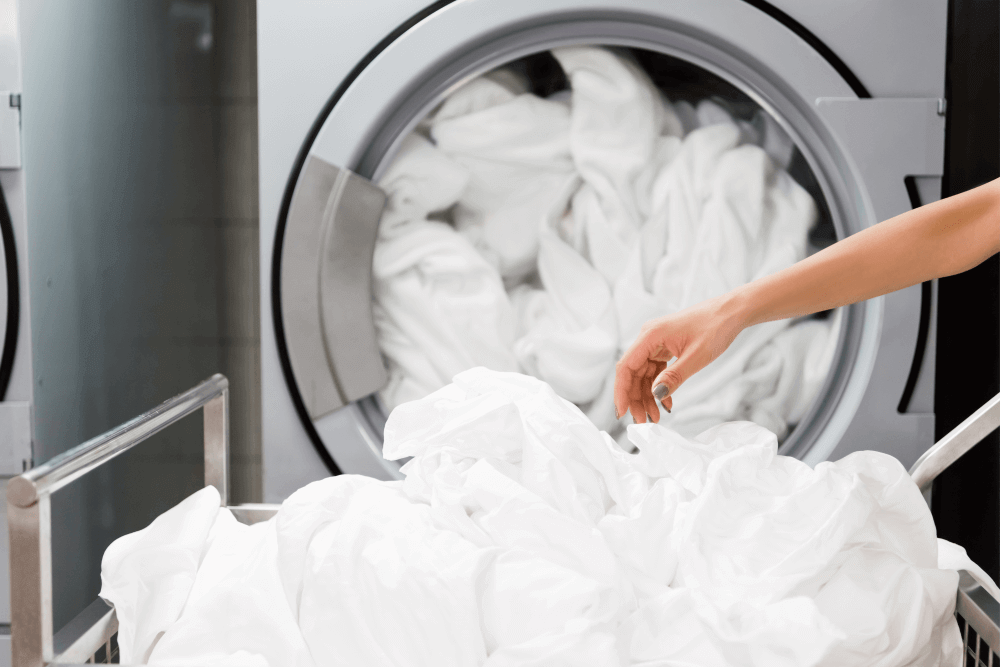How to avoid cross-contamination in care home laundry


There are ever-increasing risks of exposure to microbiological contamination within care homes, which has a direct impact on laundry processing, operations, and machinery. Controlling where, how, and when the laundry is moved around the care home, from bedrooms to the laundry, and then cleaned requires a level of control to prevent contaminating fresh, clean clothing, linen, and towels.
Common infections that are easily spread in care homes include:
Residents in care homes may spend more time in bed or seated, with blankets for additional warmth and comfort. As blankets, towels and bed linens are changed, soiled or contaminated fabrics must be dealt with in the best and most efficient way possible to avoid cross-contamination, reducing the risks of infection spreading throughout the care home and between residents.
Fortunately, infection control is simple if processes are set and training is provided and adhered to. Inspections from governing bodies will assess this and provide feedback on how this is currently run and if improvements need to be made.
The importance of laundry segregation
Laundry segregation is required to prevent cross-contamination, regardless of the size of the laundry. Whether you have a care home with 10 or 50 residents, the Care Quality Commission (CQC) has laid out the non-negotiables for care and residential homes in the UK.
Soiled and contaminated laundry should be segregated based on assessing the risk factors of heavily soiled linen. Bed linen, towels, and clothing belonging to residents with known infections should be separated.
Staff handling linen must ensure that it is segregated appropriately, ideally by a colour-coded system. They should wear PPC before handling contaminated fabrics, which should be stored in labelled containers if they cannot be added to the washing machines immediately and divided by the following;
Segregating laundry rooms may seem daunting, but the team at WASHCO has years of experience advising clients with their care home laundry needs and providing the machinery to deliver an organised, efficient, and professional laundry service. Amanda Symmons, Care Specialist at WASHCO, would advise:
Ideally, the layout should have 1/3 of the space on the dirty side and 2/3 on the clean side. You don’t need a full barrier wall, as per the original drawing below, but separating the dirty and clean side is encouraged, either with a dwarf wall or a different colour floor to help the operators identify which side of the laundry the staff are working on.
On the dirty side, you must protect yourself from any potential foul or infected linen by wearing suitable disposable gloves and aprons.
Once the laundry is clean, you need to protect the linen from being decontaminated and it is recommended you don’t touch this more than four times from when it comes out of the washer to when it is returned to the resident.
Care should be taken to the flow of linen and the ‘bed to bed’ principle, e.g. every stage of the laundry cycle management from dirty bedroom back to clean bedroom.
Appropriate and separate trollies need to be used for clean and dirty linen, and any ‘red bag’ linen should be stored separately from standard laundry.
The best way to calculate capacity is to look at the level of care and the amount of beds. For example:
A 60-bed care home with a standard 8 hour a day, seven day a week laundry operation would need approximately 30kg wash capacity (in total) so 60 x 0.5 = 30kg.
For nursing care, this rises to 60 x 0.6 = 36kg (2 x 18kg washers)
For dementia care, this is 60 x 0.8 = 48kg. ( 2 x 18 + 1 x 13kg)
Match dryers with the above, a roller ironer (for flatwork), an ironing table (for clothes), a hanging rail for garments, and delicate items that can’t be tumble-dried and your laundry room will run efficiently and to standard.
(click image to enlarge)
To prevent cross-contamination, there is must-have equipment that every care home laundry needs.
Segregated laundry containers are essential for identifying which laundry needs to go where and can prevent mistakes, which can increase the risk of an infection outbreak. Infected laundry should be sealed in soluble bags, reducing the need for direct contact and making it easy for staff to identify laundry that has already been identified as contaminated.
It’s crucial that staff, as well as residents, are protected against contaminated laundry. Gloves, aprons, and masks should be worn when handling washing and replaced each time with fresh PPE. Staff should also be fully trained on the procedures for disposing of any PPE that has come into contact with soiled and contaminated laundry.
Visible signage and user guides in laundry rooms are essential. They ensure that all staff are aware of expectations and regulations that are being adhered to when handling and sorting laundry.
Commercial laundry machines have specific settings for infection control, including thermo settings and automatic dosage, which adhere to the specific regulations set by the CQC.
So, what is the must-have laundry equipment for care homes:
Washing Machines
Dryers
As experts in providing care home laundry equipment, advice and information, get in touch to discuss replacing or renting your commercial laundry machinery for your care home.